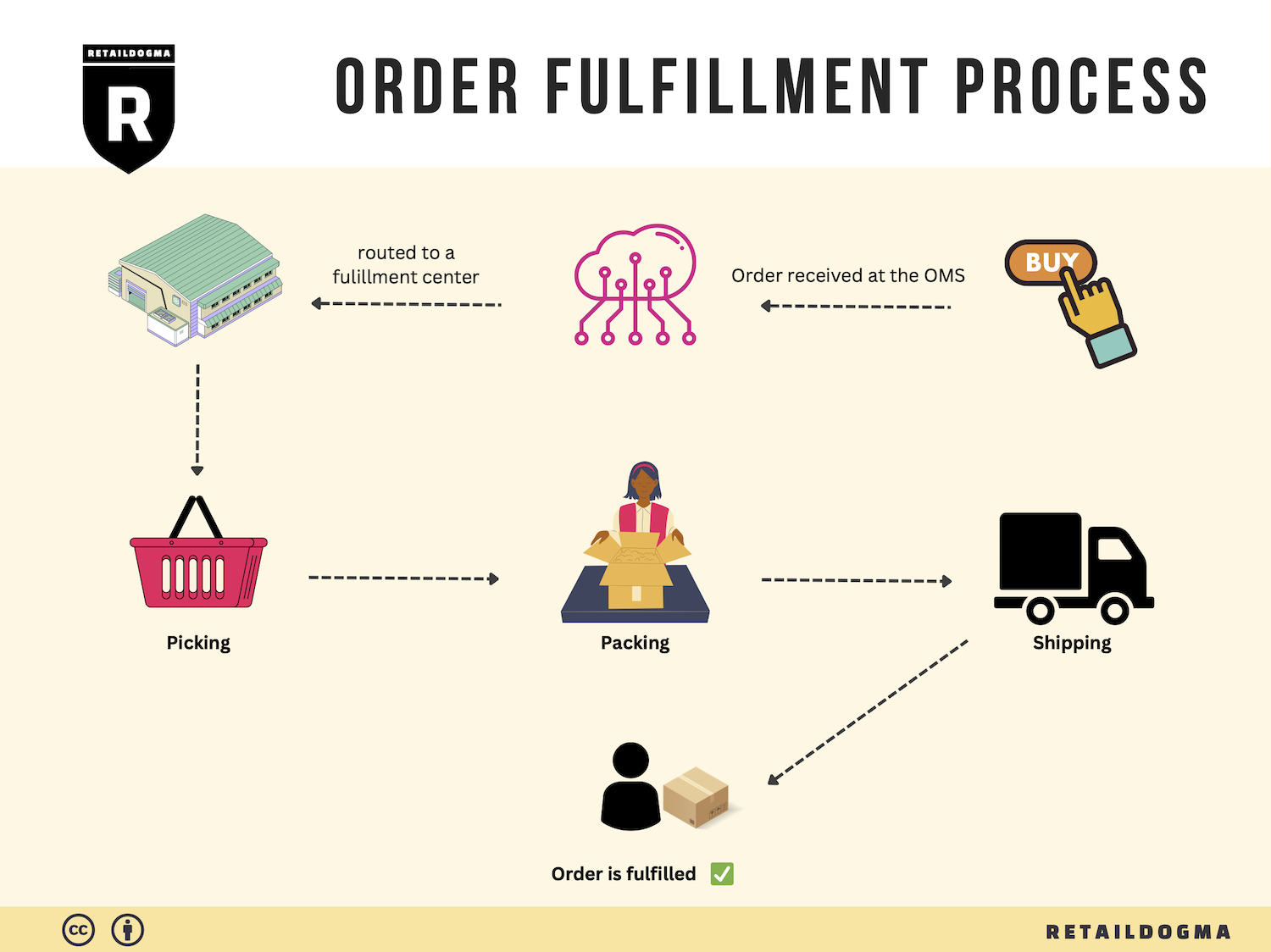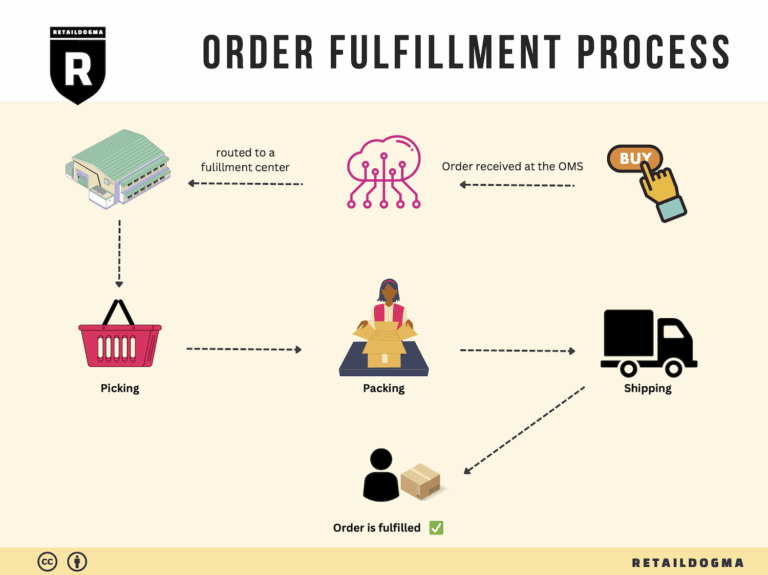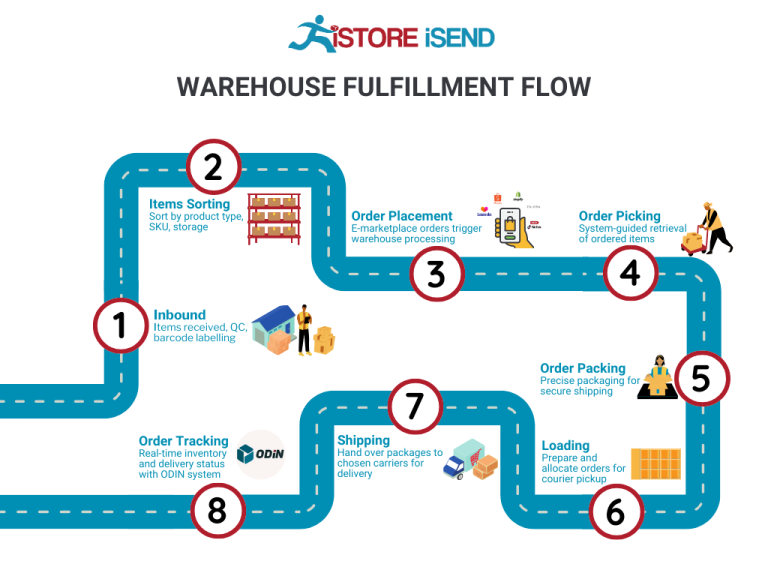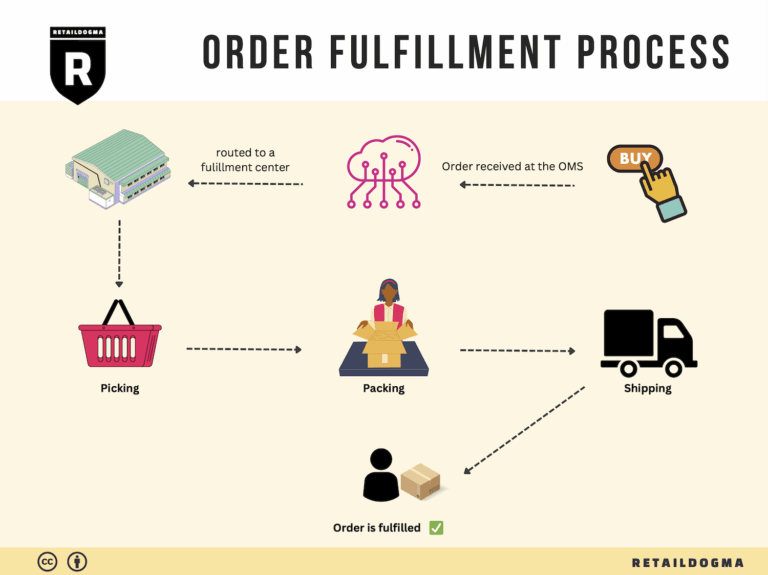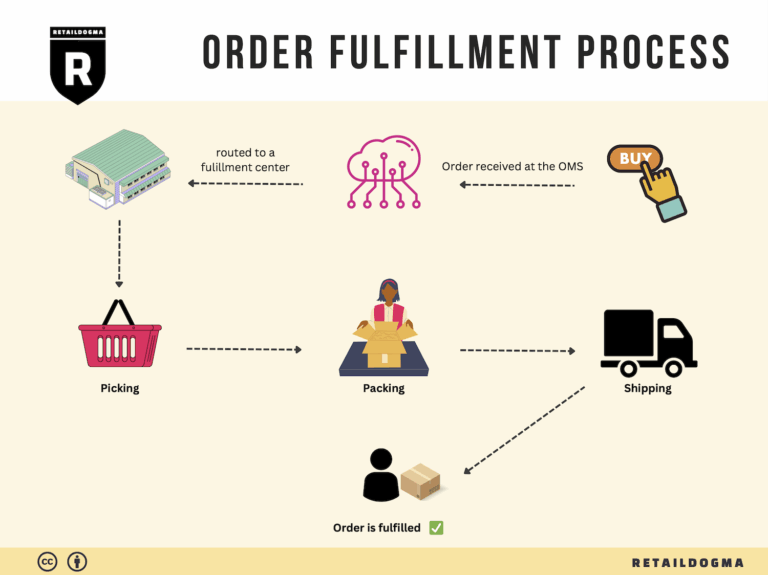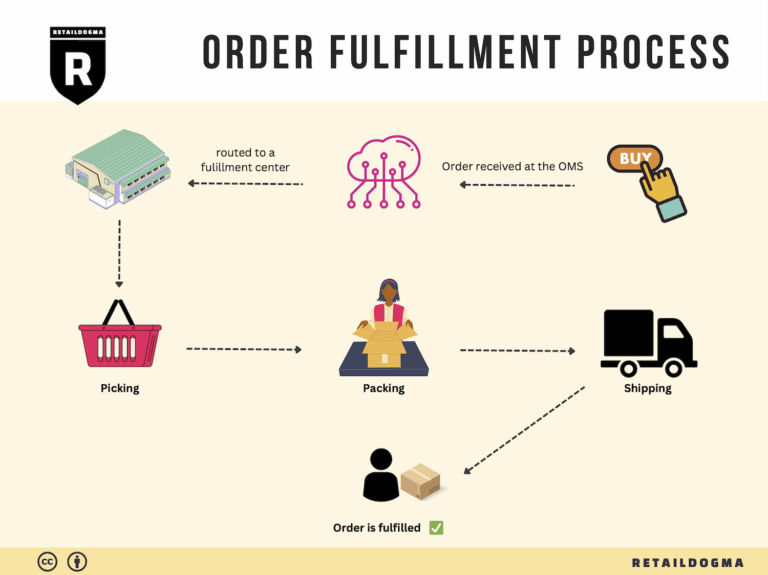What Is A Fulfillment Center? A Complete Guide (2025)
What is E-commerce Fulfillment? An Introduction for Growing Businesses
Understanding E-commerce Fulfillment
As a growing online business owner, you may often find yourself overwhelmed by the complexities of packing and shipping orders. Managing logistics can quickly become a daunting task, diverting your focus from core business activities like marketing and product development. The good news is that e-commerce fulfillment offers a structured way to simplify this process, allowing you to efficiently deliver products to your customers.
At its core, fulfillment is the process of getting a product from your warehouse or supplier to your customer’s doorstep. This involves several steps, including inventory management, order processing, picking and packing, shipping, and handling returns. Each of these components plays a critical role in ensuring that your customers receive their orders promptly and in excellent condition.
In this guide, we will explore various fulfillment models that can help streamline your operations, including third-party logistics (3PL) and Fulfillment by Amazon (FBA). Understanding these options will empower you to choose the best strategy for your business. We will delve into the core services offered by fulfillment partners, such as warehousing, shipping, and customer support, and discuss how these services can be tailored to meet your specific needs.
Choosing the right fulfillment partner is crucial for the success of your e-commerce business. We will provide practical tips on what to look for in a logistics provider, including their technology capabilities, service levels, and pricing structures. Understanding these factors will help you make informed decisions that align with your business objectives.
Finally, pricing can often be a significant concern for growing businesses. We will break down the costs associated with different fulfillment models, helping you to understand the trade-offs involved and how to optimize your logistics budget.
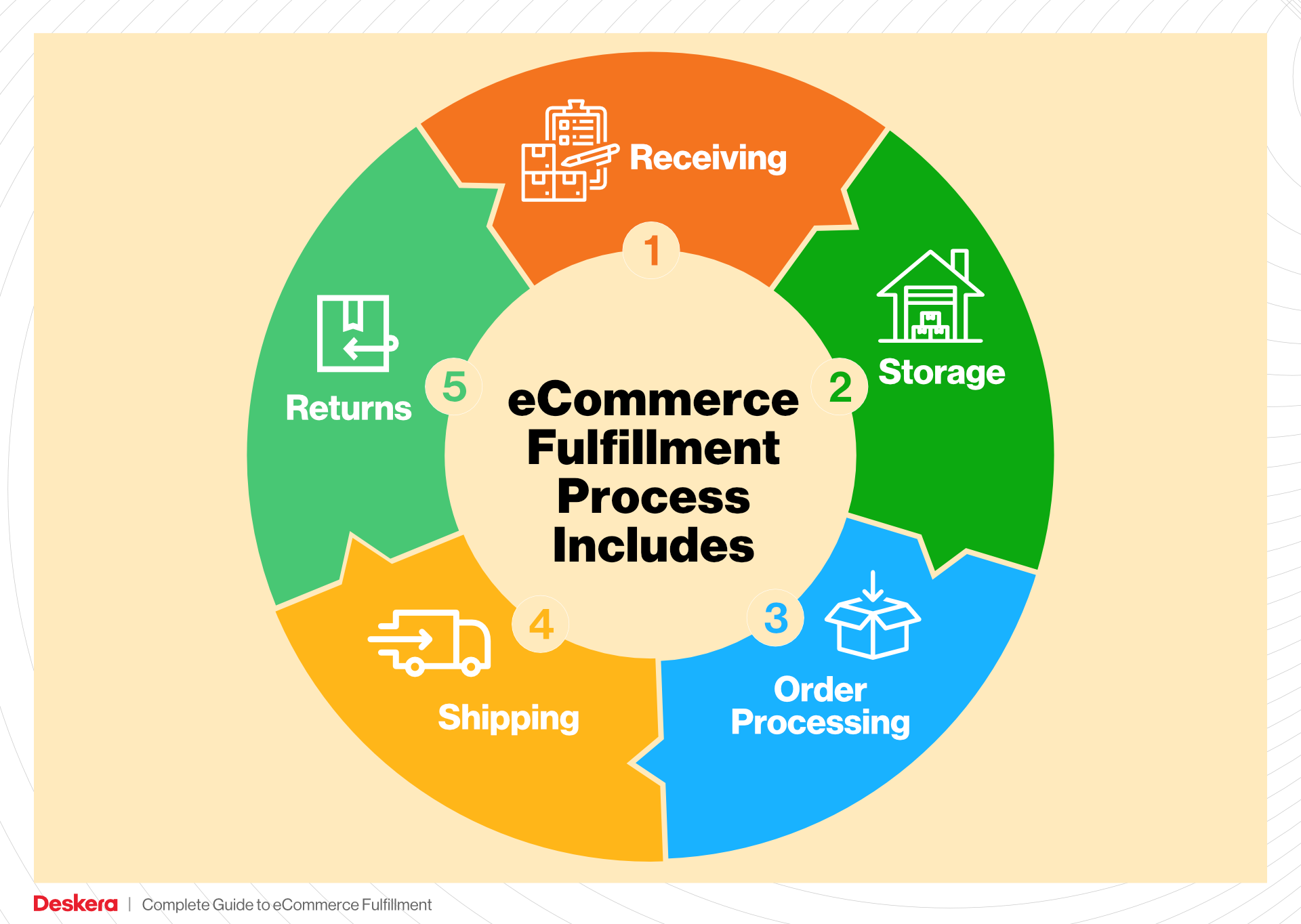
The goal of this guide is to empower you with the knowledge and insights needed to make smart decisions about your logistics operations. By navigating the complexities of e-commerce fulfillment effectively, you can scale your business, enhance customer satisfaction, and ultimately drive growth. Let’s embark on this journey to simplify your fulfillment processes and elevate your e-commerce business to new heights.
What You’ll Learn In This Guide
- What is E-commerce Fulfillment? An Introduction for Growing Businesses
- The Order Fulfillment Process: From ‘Buy’ Button to Customer’s Door
- Comparing Fulfillment Models: In-House vs. 3PL vs. Dropshipping
- A Deep Dive into Amazon FBA: Pros, Cons, and Who It’s For
- Core Services Offered by Fulfillment Centers
- How to Choose a Fulfillment Partner: A 6-Point Checklist
- Understanding Fulfillment Pricing: A Breakdown of Common Fees
- Frequently Asked Questions (FAQs) about Fulfillment
- Conclusion: Is Outsourcing Fulfillment the Right Move for Your Business?
- Important Disclaimer
The Order Fulfillment Process: From ‘Buy’ Button to Customer’s Door
1. Receiving Inventory
The order fulfillment process begins with the receiving of inventory. This step involves the careful acceptance of products from suppliers or manufacturers into your warehouse. When goods arrive, they are checked against purchase orders to ensure that the correct quantities and items have been delivered. This process typically involves scanning the products using Stock Keeping Units (SKUs), which are unique identifiers that help track inventory accurately.
Receiving inventory is critical because it establishes the foundation for all subsequent fulfillment activities. Any discrepancies at this stage—such as missing items or damages—can lead to delays and complications down the line. Efficient receiving processes not only prevent errors but also optimize inventory management, ensuring that your stock levels are accurate and up-to-date. This accuracy directly impacts your ability to fulfill customer orders promptly and reliably.
2. Warehouse Storage
Once the inventory is received, the next step is warehouse storage. This involves organizing and storing products in designated areas of your warehouse. Effective storage solutions utilize strategies such as ABC analysis to categorize items based on their sales velocity, ensuring that fast-moving products are easily accessible while slower-moving items are stored more strategically.
Proper warehouse storage is essential for maximizing space utilization and ensuring that products are easy to locate when orders come in. A well-organized warehouse minimizes the time spent searching for items, which directly contributes to faster order fulfillment. This efficiency can significantly enhance customer satisfaction, as timely delivery is a key component of excellent service.
3. Order Picking
The next step in the order fulfillment process is order picking, where items are retrieved from their storage locations to fulfill customer orders. This process can be facilitated through various methods, including pick lists, which are generated to guide warehouse staff on which items to collect for each order. Technologies such as barcode scanners or pick-to-light systems can also be employed to streamline this process.
Order picking is a pivotal stage because it directly affects the accuracy and speed of order fulfillment. Errors in picking can lead to incorrect shipments, resulting in customer dissatisfaction and increased return rates. An efficient picking process ensures that orders are fulfilled correctly and promptly, which is vital for maintaining customer trust and loyalty.
4. Order Packing
After items are picked, they move on to the order packing stage. Here, the picked items are carefully packed into boxes or containers for shipping. This step often involves using packing slips, which provide a summary of the items included in the shipment, and may also include return labels to facilitate returns if necessary.
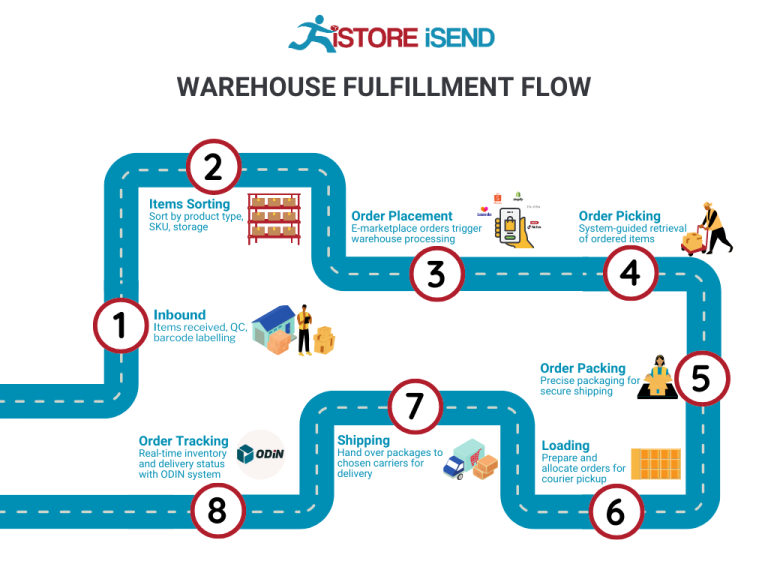
Packing is crucial for protecting products during transit and ensuring that they arrive at the customer’s location in excellent condition. Proper packing techniques can reduce the risk of damage, while effective use of packing materials helps optimize shipping costs. Additionally, a well-packed order can enhance the customer experience, making unboxing a positive part of the purchasing journey.
5. Shipping & Delivery
The final step in the order fulfillment process is shipping and delivery. Once orders are packed, they are handed off to a carrier for transportation to the customer’s address. This stage includes generating shipping labels and tracking numbers, which allow both the business and the customer to monitor the shipment’s progress.
Shipping and delivery are vital components of the customer experience. Customers expect their orders to arrive on time and in good condition, so choosing reliable carriers and optimizing shipping routes are essential for meeting these expectations. Offering various shipping options, including expedited services, can also cater to different customer needs and preferences, ultimately driving customer satisfaction and repeat business.
By understanding and optimizing each of these five steps—receiving inventory, warehouse storage, order picking, order packing, and shipping & delivery—e-commerce businesses can enhance their order fulfillment processes. This not only improves operational efficiency but also contributes to a superior customer experience, which is essential for scaling success in the competitive e-commerce landscape.
Comparing Fulfillment Models: In-House vs. 3PL vs. Dropshipping
Fulfillment Model Comparison
| Model | Who Handles Inventory | Best For (Business Stage) | Key Advantage | Key Disadvantage |
|---|---|---|---|---|
| In-House Fulfillment | The business itself | Established businesses | Greater control over inventory and fulfillment process | High overhead costs and resource allocation required |
| Third-Party Logistics (3PL) | Third-party provider | Growing businesses | Scalable solutions and expertise in logistics | Less direct control over inventory and processes |
| Dropshipping | Supplier or manufacturer | Startups and niche businesses | Low upfront investment and minimal operational costs | Lower profit margins and reliance on supplier reliability |
In-House Fulfillment
In-house fulfillment involves managing the entire inventory and shipping process within your own facilities. This model is best suited for established businesses that have the resources to invest in warehousing, staffing, and logistics management. One of the key advantages of in-house fulfillment is the level of control it provides over inventory management, shipping times, and customer service. Businesses can tailor the fulfillment process to their specific needs and respond quickly to customer demands. However, this model also comes with significant disadvantages. The overhead costs associated with maintaining a warehouse, hiring staff, and managing logistics can be substantial. Furthermore, the need for specialized knowledge in logistics and inventory management can strain resources, particularly for businesses looking to scale.
Third-Party Logistics (3PL)
Third-party logistics (3PL) refers to outsourcing your logistics and fulfillment operations to a specialized provider. This model is ideal for growing businesses that may not yet have the infrastructure or expertise to manage logistics effectively. One of the primary advantages of partnering with a 3PL is scalability; as your business grows, the 3PL can easily accommodate increased order volumes without requiring significant investment from your side. Additionally, 3PL providers like Amware bring specialized knowledge and technology that can enhance operational efficiency. However, a notable downside is the reduced control over inventory and fulfillment processes. When relying on a third party, businesses may experience delays or issues that are outside their immediate control, which can affect customer satisfaction. Furthermore, there may be hidden costs associated with 3PL services that can impact profit margins.
Dropshipping
Dropshipping is a fulfillment model where a retailer does not keep the products it sells in stock. Instead, when a retailer sells a product, it purchases the item from a third party and has it shipped directly to the customer. This model is particularly suitable for startups and niche businesses that want to minimize upfront investment and operational complexity. The main advantage of dropshipping is the low barrier to entry; businesses can start selling without the need for a warehouse or significant inventory. This model also allows for a wide variety of products to be offered without the financial risks associated with unsold stock. However, dropshipping comes with its own set of challenges. Profit margins tend to be lower compared to traditional retail models, and businesses are heavily reliant on the reliability of their suppliers for inventory and shipping. Additionally, issues such as shipping delays or product quality can impact customer satisfaction, which can be particularly detrimental for a new business trying to establish a reputation.
Conclusion
Choosing the right fulfillment model is critical for the success and scalability of your e-commerce business. Each model—In-house fulfillment, 3PL, and dropshipping—offers distinct advantages and disadvantages that should be carefully considered based on your business’s current stage, resources, and long-term goals. By understanding these models, you can make informed decisions that align with your operational capabilities and customer expectations, ultimately enhancing your logistics strategy and driving growth.
A Deep Dive into Amazon FBA: Pros, Cons, and Who It’s For
Understanding Fulfillment by Amazon (FBA)
Fulfillment by Amazon (FBA) is a service offered by Amazon that allows sellers to store their products in Amazon’s fulfillment centers. Amazon takes care of storage, packaging, and shipping, as well as customer service and returns for these products. This service is particularly attractive to e-commerce businesses looking to leverage Amazon’s vast logistics network and customer base.
When a customer places an order for a product fulfilled by FBA, Amazon picks, packs, and ships the item directly to the customer. Sellers benefit from Amazon’s extensive reach and can focus on growing their business while Amazon handles the logistics.
How FBA Works
- Setup: Sellers start by creating an Amazon Seller Account. They can then enroll in FBA and set up their product listings.
- Inventory Shipment: Sellers prepare their products and ship them to Amazon’s fulfillment centers. Amazon provides specific guidelines on packaging and labeling.
- Storage: Once the inventory arrives at the fulfillment center, it is stored until sold. Amazon manages the inventory and provides real-time visibility into stock levels.
- Order Processing: When a customer orders a product, Amazon handles the entire fulfillment process, including picking, packing, and shipping the product.
- Customer Service: Amazon also manages customer inquiries, returns, and refunds, providing a seamless experience for buyers.
- Multi-Channel Fulfillment: Sellers can use FBA to fulfill orders not only from Amazon but also from other sales channels like their own websites or other marketplaces.
Pros of Using FBA
Prime Eligibility
One of the most significant advantages of FBA is that products fulfilled through this service are automatically eligible for Amazon Prime. This means your products can be shipped with expedited delivery options, making them more attractive to millions of Prime members. The Prime badge can significantly increase your sales potential.
Customer Trust
Amazon is synonymous with trust and reliability. By using FBA, sellers can benefit from Amazon’s reputation. Customers are more likely to purchase products fulfilled by Amazon due to the assurance of quality service, prompt delivery, and easy returns.
Multi-Channel Fulfillment
FBA allows sellers to extend their reach beyond Amazon. With multi-channel fulfillment, sellers can use FBA to fulfill orders from their e-commerce websites or other platforms. This flexibility enables businesses to streamline their operations and maintain consistent inventory levels across various sales channels.
Scalability
FBA is designed to scale with your business. Whether you are a small seller or a large enterprise, Amazon can accommodate your growing inventory and order volume without requiring additional infrastructure from you.
Time Savings
By outsourcing fulfillment to Amazon, sellers can free up valuable time to focus on other aspects of their business, such as marketing, product development, and customer engagement.
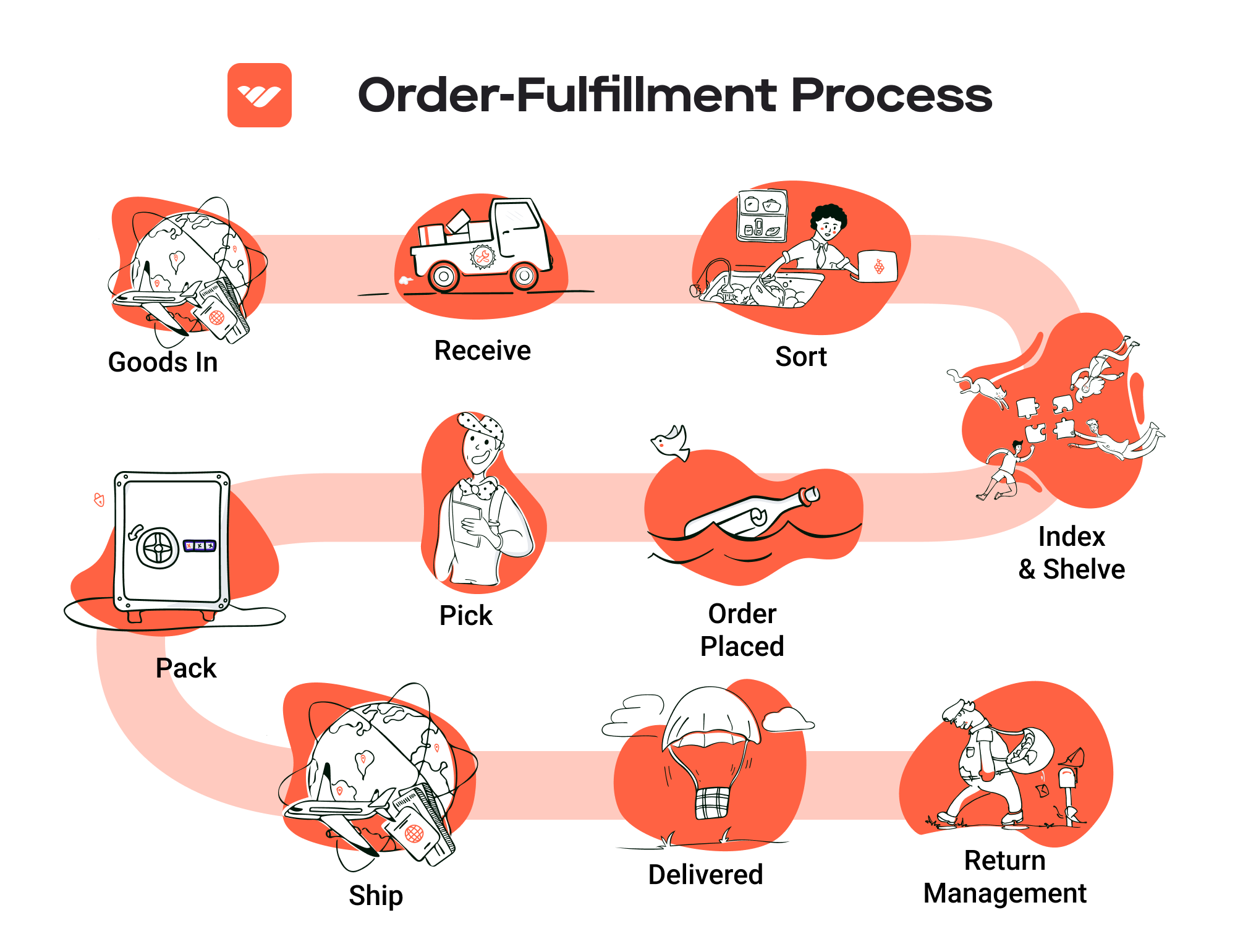
Cons of Using FBA
High Fees
While FBA offers numerous benefits, the costs can add up quickly. Sellers must pay for storage fees, fulfillment fees, and additional charges for long-term storage. For businesses with thin margins, these fees can significantly impact profitability.
Strict Inventory Rules
Amazon has stringent inventory management policies. Sellers must adhere to specific guidelines regarding packaging, labeling, and inventory levels. Failure to comply can result in penalties, including additional fees or the return of unsold inventory.
Commingling Risks
FBA operates on a commingling model, where inventory from different sellers is stored together. This can lead to issues if a customer receives the wrong item. While Amazon addresses these concerns, the potential for mix-ups can be a significant drawback for sellers who prioritize brand integrity.
Limited Control
Using FBA means relinquishing some control over the fulfillment process. Sellers have limited visibility into how their products are handled once they are in Amazon’s fulfillment centers, which can be concerning for brands that value customer experience.
Inventory Management Challenges
While Amazon provides tools for inventory management, sellers must still keep a close eye on stock levels. Running out of stock can lead to lost sales and decreased visibility on Amazon, while overstocking can result in high storage fees.
Who is FBA Best For?
Fulfillment by Amazon is best suited for businesses that want to leverage Amazon’s vast distribution network without managing the complexities of logistics themselves. It is ideal for:
- Small to Medium-Sized Businesses: Those looking to scale quickly without investing heavily in their own fulfillment infrastructure.
- E-commerce Startups: New businesses that want to tap into the Amazon marketplace and reach a large customer base from the outset.
- Sellers with Established Products: Businesses with proven products that have demand and can afford the associated fees while benefiting from Prime eligibility and Amazon’s customer trust.
- Multi-Channel Retailers: Sellers who want a streamlined fulfillment process for orders from multiple platforms, allowing them to maintain consistent service levels.
In conclusion, Fulfillment by Amazon offers a robust solution for e-commerce businesses looking to enhance their logistics capabilities and scale their operations. However, it is essential for sellers to weigh the benefits against the potential drawbacks to determine if FBA aligns with their business goals and operational strategies.
Core Services Offered by Fulfillment Centers
Inventory Management & Warehousing
Inventory management and warehousing are foundational services provided by fulfillment centers, playing a crucial role in the logistics of e-commerce businesses. This service encompasses the storage, organization, and tracking of products in a warehouse environment. Fulfillment centers utilize advanced inventory management systems that provide real-time visibility into stock levels, allowing businesses to monitor their inventory accurately.
Benefits for E-commerce Businesses:
-
Enhanced Efficiency: By outsourcing inventory management to a fulfillment center, e-commerce businesses can streamline their operations. Fulfillment centers employ sophisticated systems that minimize human error and optimize storage space, ensuring that products are easily accessible and can be quickly retrieved when orders are placed.
-
Scalability: As your e-commerce business grows, so does your inventory. Fulfillment centers offer scalable warehousing solutions, enabling businesses to expand their inventory without the need for significant upfront investment in additional storage facilities. This flexibility allows businesses to adapt to market demands seamlessly.
-
Cost-Effective Solutions: Maintaining an in-house warehouse can be costly due to overhead expenses such as rent, utilities, and staffing. Partnering with a fulfillment center transforms these fixed costs into variable costs, allowing businesses to pay only for the space and services they use, ultimately optimizing their budget.
Pick and Pack Services
Pick and pack services are integral to the fulfillment process, involving the selection of ordered items from inventory and packing them for shipment. This service streamlines the order fulfillment process and ensures that products are accurately packed according to customer specifications.
Benefits for E-commerce Businesses:
-
Accuracy and Speed: Fulfillment centers employ trained staff and advanced technology to pick and pack orders efficiently. This reduces the likelihood of errors in order fulfillment, enhancing customer satisfaction and trust in your brand. Quick turnaround times in picking and packing also ensure that orders reach customers faster.
-
Custom Packaging Options: Many fulfillment centers offer customizable packing options that allow businesses to create a unique unboxing experience for their customers. This can include branded packaging, inserts, or promotional materials that enhance customer engagement and loyalty.
-
Inventory Optimization: By outsourcing pick and pack services, businesses can maintain optimal inventory levels. Fulfillment centers track inventory turnover rates and provide insights into which products are selling well, allowing businesses to adjust their stock levels accordingly and reduce excess inventory.
Kitting and Assembly
Kitting and assembly services refer to the process of grouping individual items together to create a single product or kit. This service is particularly beneficial for e-commerce businesses that offer product bundles, promotional kits, or custom orders that require assembly before shipping.
Benefits for E-commerce Businesses:
-
Streamlined Operations: Kitting and assembly services reduce the complexity of order fulfillment by preparing products in advance. This not only saves time during the packing process but also minimizes the risk of errors, ensuring that customers receive exactly what they ordered.
-
Improved Customer Experience: Offering product bundles or kits can enhance the shopping experience for customers. By utilizing kitting services, businesses can create attractive bundles that provide added value, encouraging customers to purchase more and increasing overall sales.
-
Flexibility and Customization: Kitting services allow e-commerce businesses to adapt quickly to changing market trends. Whether it’s launching a new product line or creating seasonal promotions, fulfillment centers can assemble kits on demand, providing businesses with the agility they need to stay competitive.
Returns Management (Reverse Logistics)
Returns management, or reverse logistics, is a critical service provided by fulfillment centers that involves handling product returns efficiently. This process includes receiving returned items, inspecting their condition, restocking them, or processing them for repairs or disposal.
Benefits for E-commerce Businesses:
-
Streamlined Return Processes: A well-managed returns process is vital for customer satisfaction. Fulfillment centers specialize in handling returns efficiently, ensuring that customers have a hassle-free experience. This can lead to increased customer loyalty and repeat business.
-
Cost Reduction: Managing returns in-house can be resource-intensive and costly. By outsourcing returns management to a fulfillment center, businesses can reduce labor costs and streamline the reverse logistics process. Fulfillment centers often have established processes in place to handle returns, making it more efficient.
-
Data Insights: Fulfillment centers can provide valuable insights into return patterns and reasons for returns. This data can help e-commerce businesses identify potential issues with their products or services, allowing them to make necessary improvements and reduce future returns.
In conclusion, partnering with a fulfillment center offers e-commerce businesses a comprehensive suite of services that can significantly enhance operational efficiency, improve customer satisfaction, and drive growth. By leveraging these core services, businesses can focus on their core competencies while leaving the complexities of logistics and fulfillment to the experts.
How to Choose a Fulfillment Partner: A 6-Point Checklist
Location & Warehouse Network
When selecting a fulfillment partner, the geographical location of their warehouses is crucial. A well-placed warehouse network can significantly influence shipping costs and delivery times, enhancing customer satisfaction.
Why It’s Important:
– Proximity to your customer base can lead to faster shipping times and reduced transportation costs.
– A diverse warehouse network can help you reach various markets more effectively.
Questions to Ask:
1. Where are your warehouses located, and how do they align with my customer demographics?
2. Do you have plans to expand your warehouse network in the future?
3. How do you manage inventory across multiple locations to ensure accuracy and efficiency?
Technology & Integrations
In today’s e-commerce landscape, leveraging technology is essential for efficient order processing and inventory management. A fulfillment partner should offer robust technology solutions that integrate seamlessly with your existing systems.
Why It’s Important:
– Advanced technology can streamline operations, reduce errors, and enhance visibility into your supply chain.
– Integrations with platforms like Shopify, Amazon, or custom APIs can simplify order processing and inventory management.
Questions to Ask:
1. What proprietary technology do you offer, and how does it enhance fulfillment operations?
2. Can your systems integrate with my existing e-commerce platform and other software solutions?
3. How do you ensure data security and compliance within your technology framework?
Specializations (e.g., Cold Storage, Oversized Items)
Different businesses have unique needs based on their products. It’s essential to choose a fulfillment partner that specializes in handling your specific product types, whether they require temperature control, special handling, or unique packaging.
Why It’s Important:
– Specialized fulfillment services can ensure that your products are handled properly, reducing the risk of damage and ensuring compliance with industry regulations.
– Expertise in specific areas can provide added value through tailored solutions that meet your business requirements.
Questions to Ask:
1. What types of products do you specialize in handling, and what specific services do you offer for those products?
2. Can you accommodate unique storage requirements, such as cold storage for perishables or oversized items?
3. How do you manage compliance with industry regulations related to my products?
Scalability & Capacity
As your business grows, your fulfillment needs will evolve. It’s essential to partner with a fulfillment provider that can scale their services in line with your growth.
Why It’s Important:
– A partner with the capability to scale can help you avoid disruptions in service and support your expansion plans.
– Flexibility in capacity allows you to respond quickly to market demands and seasonal fluctuations.
Questions to Ask:
1. How do you manage fluctuations in order volume throughout the year?
2. What is your current capacity, and how do you plan to expand it as demand increases?
3. Can you provide examples of how you’ve supported other clients in scaling their operations?
Pricing and Contracts
Understanding the pricing structure and contract terms is critical to ensuring that your partnership is financially viable and aligns with your budget.
Why It’s Important:
– Transparent pricing helps avoid unexpected costs and allows for accurate budgeting.
– Clear contract terms establish expectations and protect both parties in the event of disputes.
Questions to Ask:
1. Can you provide a detailed breakdown of your pricing structure, including any hidden fees?
2. What are the terms of your contracts, and is there flexibility for renegotiation?
3. How do you handle price changes, and how will those changes be communicated?
Customer Support & Reviews
Exceptional customer support is a cornerstone of any successful partnership. A responsive and knowledgeable support team can help resolve issues quickly and ensure smooth operations.
Why It’s Important:
– Good customer support enhances your experience and can directly impact your own customer satisfaction levels.
– Reviews and testimonials from other clients can provide insights into the reliability and quality of service.
Questions to Ask:
1. What does your customer support structure look like, and how can I reach you in case of issues?
2. Can you provide references or case studies from other clients in my industry?
3. How do you handle customer complaints, and what is your typical response time?
Conclusion
Choosing the right fulfillment partner is a critical decision that can impact your business’s efficiency and customer satisfaction. By using this checklist, you can systematically evaluate potential partners, ensuring they align with your specific needs and growth objectives. Always remember that a strong partnership in logistics can lead to improved operational performance and a better overall experience for your customers.
Understanding Fulfillment Pricing: A Breakdown of Common Fees
Initial Setup Fees
When partnering with a fulfillment provider, the initial setup fees are often the first costs you will encounter. These fees cover the administrative and logistical efforts required to onboard your business into the fulfillment system. Initial setup may include costs for software integration, the creation of your account, and the configuration of your specific fulfillment processes tailored to your needs.
These fees can vary significantly based on the complexity of your operations and the technology involved. For instance, if you require custom API integrations or specialized software configurations, expect higher initial costs. It is crucial to discuss these fees upfront and understand what they encompass to avoid unexpected charges later.
Receiving Fees
Receiving fees are charged when your products arrive at the fulfillment center. This fee typically covers the labor required to unload, inspect, and categorize your inventory. The cost can be calculated based on the volume of goods received, with many providers charging per pallet or per hour of labor.
To keep these costs manageable, it is advisable to streamline your shipping processes to minimize the number of shipments. Consolidating shipments can lead to lower overall receiving fees since you’ll be charged less frequently, and it can also reduce the time spent on receiving operations.
Storage Fees (per pallet/bin)
Storage fees are incurred for the physical space your products occupy within the fulfillment center. These fees are generally calculated on a per-pallet or per-bin basis, depending on how your inventory is stored. The monthly fee can vary based on factors such as the size of the pallets, the duration of storage, and the specific terms negotiated with your provider.
To optimize storage costs, consider strategies such as inventory rotation and timely replenishment of stock. Regularly reviewing your inventory levels can help you avoid overstocking, which leads to unnecessary storage fees. Additionally, inquire about tiered pricing models that may provide discounts for larger volumes or longer-term commitments.
Pick & Pack Fees (per item/order)
Pick and pack fees are charges associated with the process of selecting items from inventory and packaging them for shipment. These fees can be structured per item or per order, depending on the fulfillment provider’s pricing model. The complexity of the order, such as the number of items or the need for special packaging, can also influence these fees.
To manage pick and pack costs effectively, it’s beneficial to streamline your product offerings and simplify order processes. For example, offering bundled products or standardized packaging can reduce the time and labor involved in the picking and packing stages, thereby lowering your overall fees.
Shipping Fees
Shipping fees are one of the most significant costs associated with fulfillment. These fees encompass the cost of transporting goods from the fulfillment center to your customers. Shipping fees can vary based on factors such as the shipping method chosen (e.g., standard vs. expedited), the destination, and the weight and dimensions of the package.
To optimize shipping costs, negotiate rates with carriers, consider using a fulfillment provider that offers discounted shipping rates due to high shipping volumes, and explore options like regional distribution centers to minimize shipping distances. Additionally, providing customers with various shipping options can help balance costs and delivery speed, ensuring customer satisfaction while managing expenses.
Tips for Getting an Accurate Quote
-
Be Transparent: Provide detailed information about your business model, inventory types, and anticipated order volumes. Transparency allows fulfillment providers to offer tailored quotes that accurately reflect your needs.
-
Ask About Hidden Fees: Inquire about any additional fees that may not be included in the initial quote, such as return processing fees, special handling fees, or seasonal rate changes.
-
Request a Detailed Breakdown: A comprehensive quote should outline all potential costs, including setup, receiving, storage, pick and pack, and shipping fees. This breakdown will help you compare providers more effectively.
-
Consider Long-Term Needs: If your business is expected to grow, discuss potential scalability options and how pricing may change as your order volumes increase.
-
Evaluate Value, Not Just Cost: While it’s essential to consider pricing, also assess the value of the services offered, including customer support, technology integration, and service reliability. A slightly higher cost may lead to better service and ultimately save you money.
By understanding these common fulfillment pricing models and how they are calculated, you can better navigate the complexities of logistics and make informed decisions that support your business’s growth and efficiency.
Frequently Asked Questions (FAQs) about Fulfillment
1. What is Amware Fulfillment A360?
Amware Fulfillment A360 is a comprehensive logistics solution designed to streamline e-commerce operations. It integrates warehousing, order processing, and shipping services, providing businesses with a full-service approach to managing their supply chain needs. This platform is tailored to enhance efficiency, reduce costs, and improve customer satisfaction by offering real-time visibility and control over inventory and shipments.
2. What is the difference between a warehouse and a fulfillment center?
A warehouse is primarily used for storage, focusing on keeping inventory until it is needed. In contrast, a fulfillment center is a specialized type of warehouse that handles the entire process of receiving, storing, picking, packing, and shipping orders directly to customers. Fulfillment centers are designed to facilitate quicker order processing and shipping to meet the demands of e-commerce.
3. What is a 3PL?
A Third-Party Logistics (3PL) provider, like Amware, offers outsourced logistics services that encompass the entire supply chain process. This includes warehousing, inventory management, order fulfillment, transportation, and distribution. Partnering with a 3PL allows businesses to leverage specialized expertise and resources, enabling them to focus on their core operations while enhancing their logistics efficiency.
4. How much do fulfillment services cost?
The cost of fulfillment services varies based on several factors, including the volume of orders, the type of products being handled, and the specific services required (such as storage, picking, packing, and shipping). Typically, fulfillment costs can include per-order fees, storage fees, and shipping costs. It is advisable to consult with Amware to get a tailored quote based on your business needs.
5. How can Amware help my business scale?
Amware provides scalable logistics solutions that can grow with your business. With a focus on flexibility, their services can be adjusted to accommodate changes in order volume, product lines, or market demands. This adaptability ensures that you can efficiently manage increased sales without compromising service quality or customer satisfaction.
6. What types of products can Amware fulfill?
Amware is equipped to handle a wide range of products across various industries. This includes consumer goods, electronics, apparel, and specialized items requiring specific handling. Their expertise in diverse logistics solutions ensures that they can cater to the unique needs of your product line.
7. How does Amware ensure timely delivery?
Amware employs a robust logistics network and proprietary transportation management system to optimize routing and scheduling. Their commitment to dedicated customer service means that you have access to real-time updates and support, ensuring that deliveries are made on time and that any issues are promptly addressed.
8. What kind of technology does Amware use for fulfillment?
Amware utilizes proprietary software that integrates seamlessly with various e-commerce platforms. This technology provides real-time inventory tracking, order management, and reporting capabilities. The system is designed to enhance visibility and streamline processes, allowing businesses to efficiently manage their logistics operations.
9. Can I customize my fulfillment services with Amware?
Yes, Amware offers tailored solutions that align with your specific business needs. During the onboarding process, their team collaborates with you to design a fulfillment strategy that meets your operational requirements, whether that includes specialized packaging, custom order processing, or specific shipping options.
10. How do I get started with Amware Fulfillment A360?
To get started with Amware, you can reach out via their website to schedule a discovery call. During this call, a dedicated sales agent will assess your logistics needs and goals, allowing Amware to develop a customized fulfillment solution that suits your business. The integration process is designed to be seamless, ensuring that you can quickly leverage their services.
Conclusion: Is Outsourcing Fulfillment the Right Move for Your Business?
The Value of Outsourcing Fulfillment
In the ever-evolving landscape of e-commerce, outsourcing fulfillment can be a transformative strategy for your business. By leveraging a dedicated fulfillment partner, you can save significant time and resources that would otherwise be spent managing logistics. This allows you to focus on what matters most—growing your brand and enhancing customer satisfaction.
One of the most compelling advantages of outsourcing is scalability. As your business experiences fluctuations in demand, a proficient fulfillment service can seamlessly adjust to your needs, whether you are ramping up for peak seasons or managing unexpected spikes in orders. This flexibility not only reduces the stress of logistics management but also enables you to seize growth opportunities without the burden of additional operational complexities.
Furthermore, partnering with an experienced fulfillment provider brings a wealth of expertise to the table. Companies like Amware offer tailored solutions backed by decades of industry knowledge, ensuring that your logistics operations are not just efficient but also innovative. Their commitment to customer service and operational excellence means you benefit from best practices that can help streamline your supply chain and improve overall performance.
However, the key to successful outsourcing lies in selecting the right partner. Your fulfillment provider should align with your business values and objectives, offering tailored solutions that cater to your unique needs. Conducting a thorough audit of your current shipping processes can provide valuable insights into whether a fulfillment partner is the right next step for your business.
Take Action
Evaluate your logistics strategy today. Are you facing scalability challenges or struggling with time-consuming shipping operations? Consider reaching out to a fulfillment service to explore how they can enhance your efficiency and support your growth. The right partnership could be the game-changer your business needs to thrive in the competitive e-commerce space.
Important Disclaimer
⚠️ Important Disclaimer
The information in this guide is for educational purposes. Fulfillment services, pricing, and platform features change frequently. Always conduct your own due diligence and consult with providers directly before making business decisions.
